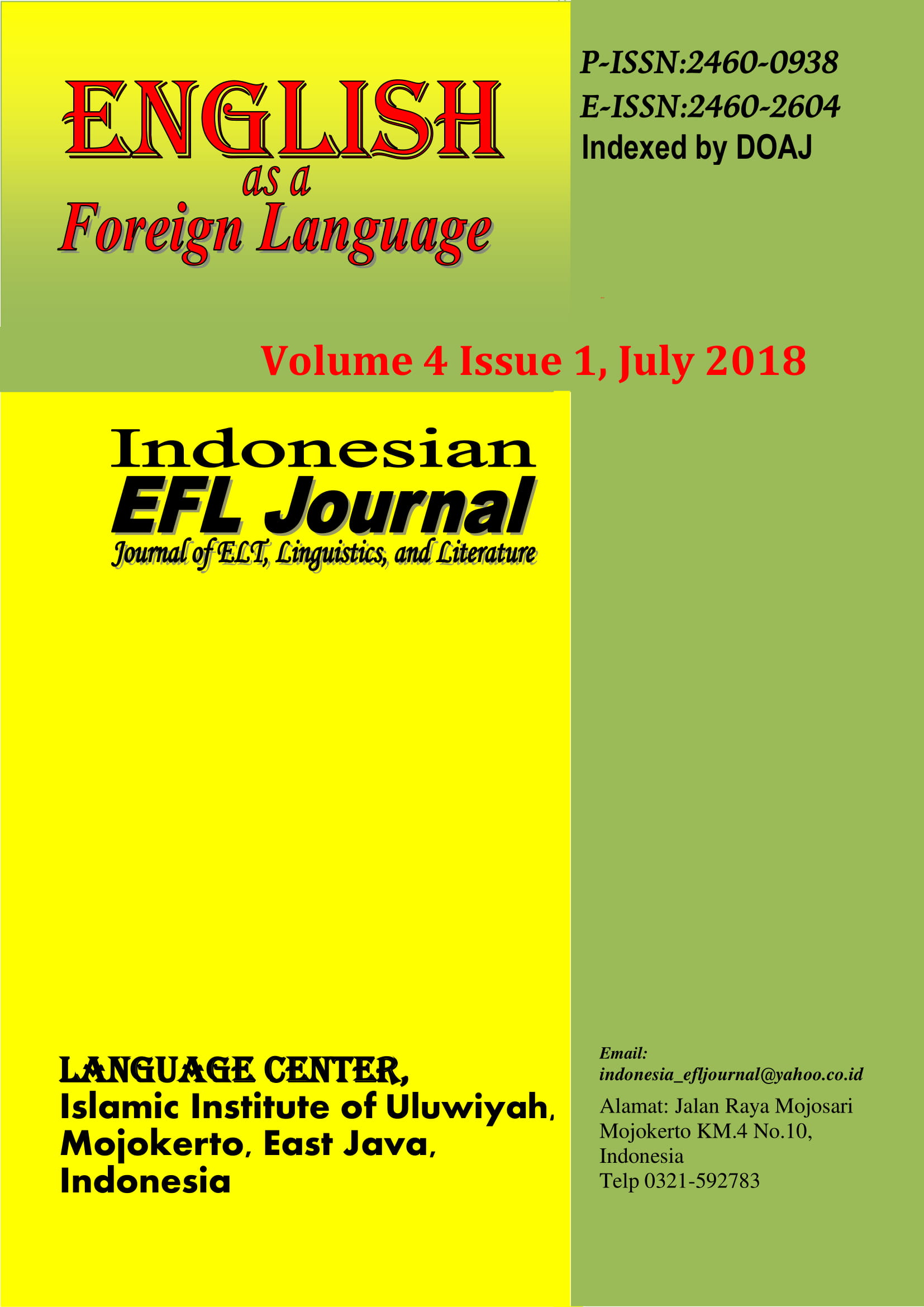Teaching and Learning Strategies of Reading Comprehension Skill for Asian Countries Students
Abstract
This study focus on how the senior high school students in the Asian countries learning English as a second language, explore their comprehension in reading skill. There are some factors mentioned about how the application in reading comprehension skill have main important role in studying and learning English as a second language and learning another subjects. The skills in reading comprehension; knowing and understanding the vocabularies, skill coding, the preparation contextual materials or modules must be appropriate and suitable with the situation and back ground of the country which are learning English as a second language taking place. How the learning strategies influence the English learning especially in reading skill by focussing on the learning strategies of female and male and how this skill in learning English influence the students’ performance science in their school. With all these reasons it will be summarized with Langan’s numeration about how to have a good reading comprehension in eight skills mentioned and there are some skills related to these journals taking from five Asian countries will be analysed.
References
Armstrong. (2003). The multiple intelligences of reading and writing, Alexandria, Virginia, USA Carido, C., & Bautista, J. (2000). Correlation analysis of admission test and academic performance in mathematics of freshmen students in Notre Dame University. NDU Faculty Journal, 1.
Chall, Joanne S. (1987) ‘Two Vocabularies for reading: recognition and meaning’, in M.G. McKeown and M.E. Curtis (eds.), The nature of vocabulary acquisition (Hillside, NJ: Lawrence Erlbaum): 7-17.
Cheah, Yin Mee 2004 ‘English language teaching in Singapore today’, in W.K. Ho and R. Wong(eds.), English language teaching in East Asia today: changing policies and practices (Singapore: Marshall Cavendish Academic): 351-74.
Curtis, Mary E.(1987). Vocabulary testing and instruction’, in M.G. McKeown
and M.E. Curtis, The nature of vocabulary acquisition (Hillside, NJ: LawrenceErlbaum): 37-51.
Dai, C., & Liu, L. (2012). The effectiveness of explicit instruction of certain
Decoding skills in improving Chinese EFL listeners’ general comprehension performance. Chinese Journal of Applied Linguistics, 35(2), 243-255.
Dochy, F., Segers, M., &Buehl, M. (1999). The relation between assessment
practices and outcomes of studies: The case of research on prior knowledge. Review of Educational Research, 69, 145–186.
Elley, W. B. (1994). The IEA study of reading literacy: achievement and
instruction in thirty-two school systems. Exeter, England: Pergamon.
Gough, P. B., Hoover, W. A., & Peterson, C. L. (1996). Some observations on a
Simple view of reading. In C. Cornoldi& J. Oakhill (Eds.), Reading comprehension difficulties (pp. 1-13). Mahwah, NJ: Lawrence Erlbaum.
Gu, P. Y. (2003). Fine Brush and Freehand1: The vocabulary learning art of two
successful Chinese EFL learners.TESOL Quarterly, 37(1), 73-104.
Hassan, F., &Selamat, N. F. (2002). Why aren’t students proficient in ESL: the
teachers’ perspective. The English Teacher, 18-29.
Imam, Mastura, Jamil, Ismail. (2014).Reading Comprehension Skill and
Performance in Science Among High School Students in the Philippines, Asia Pacifix Journal of Education, Vol. 29, 81-94.
Javed, M., Eng, L.S., Mohamed, A.R.(2015). Developing Reading Comprehension Module to facilitate reading comprehension among Malaysian secondary school ESL students. International Journal of Instruction. Retrieved at www.e-iji.net on September, 29 2017.
Kang, Huh, Moon, Park. (2014). Decoding skills vs. reading fluency in Korean high
school EFL learners’ reading comprehension. English teaching, Vol 69, No 4.
Kang, Y. (2011). Reading fluency vs. oral language comprehension in predicting
reading comprehension of Korean EFL learners. Korean Journal of Applied Linguistics, 27(4), 81-102.
Laufer, Batia, and Donald D. Sim. (1985). Measuring and explaining the
threshold needed for English for academic purposes tests, Foreign Language Annals 18(3): 405-13.
Langan. (2002). Reading and study skill,McGraw-Hill-Boston.
Lawrence, Zhang &Suaini Bin Annual. (2008). The role vocabulary in reading
comprehension: The case of secondary school students learning English in Singapore. RELC, Vol 39 (I) 51-76.
Logan, S., and Johnston, R. (2009). Gender differences in reading ability and
attitudes: Examining where these differences lie. Journal of Research in Reading 32:199-214.
Lu Fang Lin. (2010). Senior high school students’ reading comprehension of
Graded readers. Journal of language teaching and research, Vol. 1, No. 1, pp. 20-28, Retrieve at doi:10.4304/jltr.1.1.20-28 © on September, 5 2017.
Nation, I.S. Paul. (2001).Learning Vocabulary in another language (Cambridge:
Cambridge University Press).
Norris, S. P., & Phillips, L. M. (2003). How literacy in its fundamental sense is
central to scientific literacy. Science Education, 87, 224.
Orasanu J, And Penny, M. (1986). Introduction comprehension theory and how it
grew. Reading comprehension; from research to practice,(pp) 1-10.
O’Reilly, T., & McNamara, D. S. (2002). What’s a science student to do? Gray &
C. D. Schunn, Proceedings of the Twenty-Fourth Annual Meeting of the Cognitive Science Society (pp. 726–731). Mahwah, NJ: Lawrence Erlbaum.
Qian, David D. (1999). Assessing the roles of depth and breadth of vocabulary
knowledge in reading comprehension’, Canadian modern language review 56(3): 282- 308. 2002 ‘Investigating the relationship between vocabulary knowledge and academic reading performance: an assessment perspective, Language Learning 52(4): 513-36.
Richards, Jack C. 1976 ‘The Role of Vocabulary Teaching’, TESOL Quarterly
10(1): 77-89.
Schmitt, Norbert, Diane Schmitt and Caroline Clapham. (2001). Developing and
exploring the behaviour of two new versions of the
vocabulary levels test, Language Testing 18(1): 55-88.
Voss, J., &Silfies, L. (1996). Learning from history text: The interaction of
knowledge and comprehension skill with text structure cognition and instruction, 14, 45–68.
Zhang, Annual, (2008). Constructivist pedagogy in strategic reading instruction:
exploring path–ways to learner development in the English-as-a-second-language class–room’, Instructional Science: An International Journal of the Learning Sciences 36(2): 89-130, Retrieved at http://dx.doi.org/10.1007/s11251-007-9025-6 on September, 3 2017.
Copyright (c) 2018 Indonesian EFL Journal: Journal of ELT, Linguistics, and Literature

This work is licensed under a Creative Commons Attribution-ShareAlike 4.0 International License.
All rights reserved.
this publication may be reproduced, stored in a retrieval system, or transmitted
in any form or by any means, electronic, mechanical, photocopying, recording.




